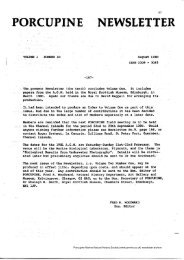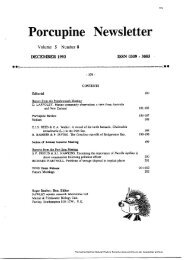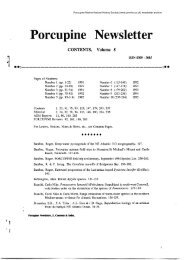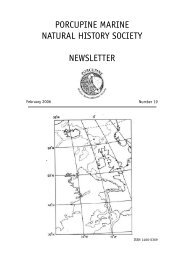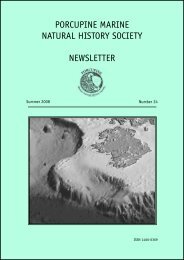Porcupine Newsletter Number 25, Winter 2008/09.
Porcupine Newsletter Number 25, Winter 2008/09.
Porcupine Newsletter Number 25, Winter 2008/09.
Create successful ePaper yourself
Turn your PDF publications into a flip-book with our unique Google optimized e-Paper software.
in the scheme indicated that they found thismodule more valuable than anticipated.Sitting in on NMBAQC meetings I see no“emerging monster” trying to take over marinemonitoring in the UK or Europe. Sure we wantthe quality mantra to spread, but we are not the“benthic police” – just a bunch of committedmarine ecologists arguing about how best todo things! Arguing about sampling equipmentand sampling techniques, about fixing andpreserving, about sieving and storing, aboutsorting and staining or about blotting andweighing. We have lengthy deliberationstoo on faunal identifications, on taxonomickeys and literature, on setting targets andstandards (not to mention keeping the schemefinancially viable) – all directed towards theend product – Quality Assured data! It shouldbe noted that all the committee members’costs are met by their respective CMA’s andnot by the scheme. This is even the case forthe contractor’s representative, who sits onthe committee to bring any issues raised bycontractors to the table.Scheme flexibility and costsThe methodologies utilised by the CMAsfor NMMP/CSEMP and WFD macrobenthicmonitoring programmes (i.e. 0.1m 2 Day orVan Veen Grabs, processed on 0.5 or 1.0mmsieves) are sufficiently similar for both tobe incorporated into the NMBAQC schemeInvertebrate Component. There has been somediscussion whether aquaculture monitoringprogrammes (which use smaller grab samples,0.02 or 0.0<strong>25</strong>m 2 ) should be assessed in thesame manner, and at the same cost, as CSEMPor WFD samples. Evidence to date suggeststhat aquaculture macrofaunal samples areoften just as diverse (and just as costly toaudit) as the larger grab samples. Althoughthis may seem counter-intuitive it may berelated to a broader mix of sediment typesaround fish farms in shallower waters, includingcoarser grits or maerls with very rich infaunalcommunities. Hence the audit procedure hasbeen deemed appropriate for both CSEMP/WFDand aquaculture samples. The committee doreview the scheme’s scope and operation andit would be misleading, as has been suggested,that the Invertebrate Component is currentlybeing used to assess survey work for which itwas not designed.While it has been argued that sampleaudit costs within the scheme should reflectthe actual audit costs of individual samplesof varying size or type, this would presentconsiderable administrative difficulties as theInvertebrate Component is required to be costedand funded as a whole in advance. Therefore,the costing is based on the estimated averagecosts of sample processing plus reporting andthe administrative overheads of the exercisesof the schemes contractor. Provided the rangeof sample types is not too large then this isgenerally simpler and fairer. While the schemedoes aim to be flexible it also has to be costefficient. Conducting and reporting qualityassurance is expensive and analytical labsfrequently spend 20-<strong>25</strong>% of their budgets onquality control alone. Separating identifiedmacrofaunal taxa into individual vials, forexample, may be considered a tedious burdenby some analysts but is routine practice in manyCMA labs to facilitate internal and external QAprocedures. Such practices do have additionalcosts and may seem like extra hoops to jumpthough, but they are necessary for properauditing. There is little point in carrying outexpensive monitoring programmes if they don’tproduce good quality assured data. Qualityassurance is not something that should “beavoided” – it should pervade all the processesfrom beginning to end (O’Reilly, 2001). Thethoroughness of the QA procedures providesconsiderable added value to the data.While the costs of participation can bebudgeted for by CMAs they may representa significant burden to individual persons/analysts vying for CMA contracts. A sharedmembership option has been introduced tohelp alleviate this difficulty. Contractors canand do, of course, pass the costs back to theCMAs via elevated charges for sample analysis.Of course it might be better if DEFRA fundedthe scheme up front with a generous blockgrant. However, government departmentshave their own ways of funding operationswhich might seem arcane to us scientists and,try as we might, it is difficult for a committeeof marine ecologists to influence governmentfiscal policy.PMNHS <strong>Newsletter</strong> No.<strong>25</strong> <strong>Winter</strong> <strong>2008</strong>/0911




